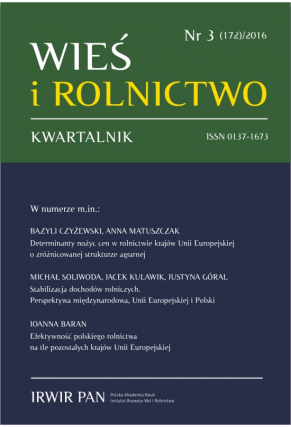Wpływ polityki i rynku na relatywną deprywację dochodową czynnika pracy w rolnictwie
DOI:
https://doi.org/10.53098/wir032017/03Słowa kluczowe:
czynnik pracy w rolnictwie, relatywna luka dochodowa, zmiana realnej produktywności, nożyce cenowe, teoria kieratu technologicznego Cochrane’aAbstrakt
W większości krajów członkowskich UE przeciętne dochody w sektorze rolnym są ciągle dużo niższe niż przeciętne wynagrodzenia w sektorach nierolniczych, co stoi w sprzeczności z jednym z pierwotnych celów WPR, jakim jest „zapewnienie odpowiedniego poziomu życia ludności rolniczej”. Głównym celem tego artykułu jest sprawdzenie, czy członkostwo w UE i korzystanie ze środków WPR pomagają zredukować relatywną lukę dochodową w rolnictwie. Drugim z celów jest zbadanie, które czynniki wpływają na tę lukę i w jaki sposób. W badaniach wykorzystano dane EAA z 27 krajów członkowskich z lat 1995–2015 i oszacowano trzy modele regresji panelowej: dla wszystkich, „starych” i „nowych” krajów członkowskich. Wyniki badań wskazują, że w krajach UE-15 cele socjalne WPR nie są realizowane, ale są osiągane w ramach systemu SAPS w krajach UE-12.Bibliografia
Banga R. (2014). Impact of Green Box Subsidies on Agricultural Productivity, Production and International Trade. Unit of Economic Cooperation and Integration Amongst Developing Countries (ECIDC). Background Paper NO. RVC-11, 15–21.
Baer-Nawrocka A. (2015). Kwestia parytetu dochodów rolniczych w krajach Unii Europejskiej. In: A. Czyżewski, B. Klepacki (eds). Problemy rozwoju rolnictwa i gospodarki żywnościowej w pierwszej dekadzie członkostwa Polski w UE. Warsaw: Wydawnictwo Naukowe PWN.
Bhandari P. (2004). Relative deprivation and migration in an agricultural setting of Nepal. Population and Environment, 5 (25), 475–499. DOI: https://doi.org/10.1023/B:POEN.0000036931.73465.79
Cai W., Pandey M. (2015). The agricultural productivity gap in Europe. Economic Inquiry, 53 (4), 1807–1817. DOI: https://doi.org/10.1111/ecin.12214
Chatterjee S., Hadi A. (2006). Regression Analysis by Example. Hoboken, N.J.: Wiley-Interscience. DOI: https://doi.org/10.1002/0470055464
Chen S., Ravallion M. (2013). More relatively-poor people in a less absolutely-poor World. The Review of Income and Wealth, 1 (59), 1–28. DOI: https://doi.org/10.1111/j.1475-4991.2012.00520.x
Ciaian P., Swinnen J. (2009). Credit market imperfections and the distribution of policy rents. American Journal of Agricultural Economics, 91 (4), 1124–1139. DOI: https://doi.org/10.1111/j.1467-8276.2009.01311.x
Cochrane W. (1958). Farm Prices: Myth and Reality. Minneapolis: University of Minnesota Press.
Czubak W., Jędrzejak P. (2011). Wykorzystanie dopłat bezpośrednich w gospodarstwach rolnych. Roczniki Naukowe SERiA, 13 (2), 75–79.
Czyżewski B., Matuszczak A. (2016). Political rents in the EU-27. Comparative analysis in political rents of European farmers. In: B. Czyżewski (ed.). The Sustainable Development Paradigm. International, National and Regional Perspective. Warsaw: Wydawnictwo Naukowe PWN.
Davis J. (1959). A formal interpretation of the theory of relative deprivation. Sociometry, 4, 280–296. DOI: https://doi.org/10.2307/2786046
European Commission (2015). EU agriculture spending – focused on results. Brussels: DG Agri Fact-Sheet.
Eurostat (2008). Handbook for EU Agricultural Price Statistics. http://ec.europa.eu/eurostat/ramon/statmanuals/files/Handbook%20for%20EU%20Agricultural%20Price%20Statistics%202008.pdf [accessed: 10.01.2017].
Eurostat (2016). Economic Accounts for Agriculture Database, http://ec.europa.eu/eurostat/web/agriculture/data/database [accessed: 10.01.2017].
Eurostat (2017). Economy and finance glossary. http://ec.europa.eu/eurostat/statistics-explained/index.php/Glossary:Entrepreneurial_income_account [accessed: 10.01.2017].
Fałkowski J. (2013). Does it matter how much land your neighbour owns? The functioning of land markets in Poland from a social comparison perspective. IDEAS Working Paper Series from RePEc, 1–20.
Grant P., Abrams D., Robertson D., Garay J. (2015). Predicting protests by disadvantaged skilled immigrants: A test of an integrated Social Identity, Relative Deprivation, Collective Efficacy (SIRDE) Model. Social Justice Research, 1 (28), 1–6. DOI: https://doi.org/10.1007/s11211-014-0229-z
Hennessy D. (1998). The production effects of agricultural income support polices under uncertainty. American Journal of Agricultural Economics, 80, 46–55. DOI: https://doi.org/10.2307/3180267
Hill B., Bradley D. (2015). Comparison of Farmers’ Incomes In The EU Member States. Study for the European Parliament’s Committee on Agriculture and Rural Development.
Hyll W., Schneider L. (2014). Relative deprivation and migration preferences. Economics Letters, 2 (122), 334–337. DOI: https://doi.org/10.1016/j.econlet.2013.12.023
Jayanta S., Dipti P. (2013). Changes in reative deprivation and social well-being. International Journal of Social Economics, 6 (40), 528–536. DOI: https://doi.org/10.1108/03068291311321839
Jonsson T. (2007). Collective action and Common Agricultural Policy lobbying: Evidence of Euro-Group influence, 1986–2003. Umea Economic Studies, 713. Umea University.
Levins R., Cochrane W. (1996). The treadmill revisited. Land Economics, 72 (4), 550–553. DOI: https://doi.org/10.2307/3146915
Liefert W. (2005). Decomposing Changes in Agricultural Price Gaps. International Agricultural Trade Research Consortium, Working papers No. 14592.
Mueller D. (2015). Profit seeking and rent-seeking in the United States and Europe. In: R. Congleton, A. Hillman (eds). Companion to the Political Economy of Rent Seeking. Cheltenham, UK: Elgar. DOI: https://doi.org/10.4337/9781782544944.00027
OECD (2016a). Agricultural support estimates. OECD Agricultural Statistics. http://dx.doi.org/10.1787/data-00737-en [accessed: 10.01.2017]. DOI: https://doi.org/10.1787/data-00737-en
OECD (2016b). Glossary of statistical terms. https://stats.oecd.org/glossary/detail.asp?ID=2890 [accessed: 10.01.2017].
Rizov M., Pokrivcak J., Ciaian P. (2013). CAP subsidies and productivity of the EU farms. Journal of Agricultural Economics, 64 (3), 537–557. DOI: https://doi.org/10.1111/1477-9552.12030
Runciman W. (1966). Relative Deprivation and Social Injustice. Berkeley: University of California Press.
Stark O., Fan S. (2011). Migration for degrading work as an escape from humiliation. Journal of Economic Behavior and Organization, 3 (77), 241–247. DOI: https://doi.org/10.1016/j.jebo.2010.10.006
Tacco B., Bailey A., Davidova S. (2013), The Reallocation of Agricultural Labour across Sectors: An Empirical Strategy for Micro Data. Factor Markets Project Working Paper No. 45.
Tomek W.G., Robinson K.L. (1981). Agricultural Product Prices. Ithaca–London: Cornell University Press.
Treaty Establishing the European Economic Community (1957). 25 March 1957, 298 U.N.T.S. 3, 4 Eur. Y.B. 412.
Yitzhaki S. (1979). Relative deprivation and the Gini coefficient. Quarterly Journal of Economics, 2 (93), 321–324. DOI: https://doi.org/10.2307/1883197
Zawalińska K., Majewski E., Wąs A. (2016). Long-term changes in the incomes of the Polish agriculture compared to the European Union countries. Annals of Polish Association of Agricultural Economists, 17 (6), 346–354.
Pobrania
Liczba pobrań artykułu
Strony
Jak cytować
Numer
Dział
Licencja
Prawa autorskie (c) 2017 Wieś i Rolnictwo

Utwór dostępny jest na licencji Creative Commons Uznanie autorstwa 4.0 Międzynarodowe.










